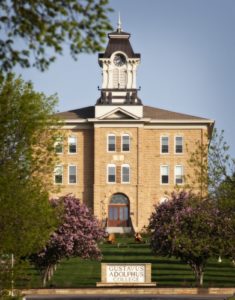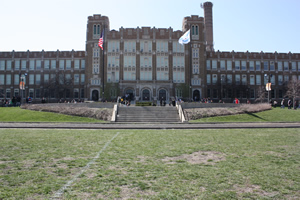Reverend Kristinn K. Ólafsson was Jóhannes Sigurgeirsson’s brother-in-law and wrote an article about his life after his death. In 1946, that article was published in Ólafur Þorgeirsson’s Almanak and follows below. It is an interesting example of a settler, born in a young Icelandic colony in Canada in 1880 and growing up among Icelandic pioneers in North Dakota, not only about his studies and life’s work, but also how he cultivated his Icelandic origins all the time.
“Icelanders in America have put a lot of effort into teaching. They have undoubtedly participated more in national life in this area than would have been expected from their population. Teaching and learning have marked many Icelandic homes. Something of that influence seems to have directed a remarkable number of people here in the west to become teachers. From the children’s school up to the best seats at the universities, you will be met by teachers of Icelandic descent. The most important thing is that these teachers usually have the best reputation. Many have been superior teachers. One of them who had a long and remarkable career and bore the mark of his status was Jóhannes (John) S. Björnson, who died in Chicago on September 25, 1944. It was as a symbol of how much the teaching profession had grown with him that he taught his regular teaching hours the last day he lived. He lived all his life in the job. Jóhannes was, when he finished his term, head teacher in the history department of Steinmetz High School in Chicago. But in addition, he had behind him a great and good part in the social life of Icelanders in Chicago for two dozen years. His leadership in that regard was known and appreciated by all. He was above mediocrity in everything he did.”

Gustavus Adolphus College Photo: St. Peters Archives
Childhood and career: “Jóhannes’ parents were Sigurgeir Björnsson and Guðfinna Jóhannesdóttir. They moved to America from Hagi in Vopnafjörður in 1876 but were Þingeyingar (their ancestry in Þingeyjarsýsla) by family and had spent most of their life in Mývatnssveit. They went with the big group to Gimli the same year and lived there for about four years. Jóhannes was born on February 15, 1880. In that year, the family moved to Dakota and lived there ever since, first in the Garðar settlement and then in the Víkur settlement outside of Mountain and later in the village itself. From childhood, Jóhannes showed a strong inclination to study. In addition to a normal elementary education, he enjoyed the valuable home education that characterized the best Icelandic country homes. His father was a librarian in the local reading club for a long time. It was a privilege for a bookish teenager to dig out of the well of Icelandic literature and at the same time to try as much as he could from American and English literature. He found, like many others, that homeschooling and a healthy desire to read are a solid foundation for continuing on the mental path. The precocious teenager finished elementary school at a very young age. Back then, there were not many high schools in these areas, and the lack of materials took teenagers away from home. Like many others, Reverend Friðrik J. Bergmann took it upon himself to prepare him for seminary. It was both in that Reverend Friðrik was an excellent teacher and also that the home schooling he provided opened many promising young people the opportunity to study, which otherwise would have gone to waste. When a good start was obtained and with strong encouragement, few returned unless there was no other option. Jóhannes was lucky enough to be supported in his studies by his parents. He attended Gustavus Adolphus College in St. Peter, Minnesota, and graduated from there with a B.A. in the spring of 1901. – Along with his studies, from the time he was sixteen years old, he had occasionally taught at a children’s school in his home settlement. He did the job very well and was a popular teacher. After completing the studies, the life situation was therefore the self-chosen one. He became principal of the school in Mountain and held that position with the best reputation. He had an excellent way of igniting interest and ambition in the youth, and many of them considered it their greatest credit to have had him as a teacher. He also took a very active part in the social life of the village and settlement. He had surely landed on the right shelf in life. He was dedicated to the job for life.

Steinmetz High School
Various locations: After he left his hometown, he superintended schools in Inkster and LaMoure, North Dakota, and in the college town of Vermillion, South Dakota. In addition, he was for a while the Deputy County Superintendent in Grand Forks County in North Dakota. He pursued parallel continuing education at the state university there and took a master’s degree (M.A.) in history. He fell in love with that subject and has taught in that field ever since. He chose to leave the school board in order to dedicate himself to teaching. That led to his moving to Chicago in 1923. He was a teacher there for a long time, first at Harrison Technical High School and then at Steinmetz High School. At the second school, which is one of the largest high schools in the city, he was appointed the school’s Head of the Social Science Department. He quickly became highly regarded by both his fellow teachers and students. His private library was renown, and he constantly added to it. He kept a close eye on all the most significant publications related to American history, so few stood up to him. He always drew from a fresh well of extensive knowledge while teaching, thus keeping the attention and interest of the students far beyond what was normal. It was quite amazing how many of his students adored him and considered him their best teacher. Fact remains that it is often considered far from an easy task to reach out to the youth of the big cities. Not a year passed that he did not receive repeated testimony of his students’ trust and love. It is only available to teachers by the grace of God.
Icelandic society: Since his childhood, Jóhannes had been in love with the Icelandic language and culture. Although he was away from Icelanders for a long time, his confidence in this matter remained unchanged. Einar Kvaran said of him when he met him that he spoke classic Icelandic. Naturally, he cared about everything Icelandic and wanted to support all Icelandic social issues. When he came to Chicago, it could be said that the Icelanders there hardly knew each other, and there was no social organization involved. He, along with other good men, played a major role in founding the Icelanders’ Association “Vísir”, which is now a member of the West Icelanders’ National League. For thirteen years, he was the president of that association, and that bears witness to the part he had in the welfare of this Icelandic association. The association was his desire, and his personal popularity was therefore a great help, in addition to the great dedication he gave to the job. There was another Icelandic association in Chicago he was involved in founding. That club is unique in its position in the history of western Icelanders. It bears the peculiar name ”T.N.T. & Company”. Most of the time there are about twelve members in the association. Meetings are held once a month throughout the year. Before the meeting, the members enjoy dinner together in the city’s Norwegian club. At each meeting, the designated member delivers a speech on a topic that he has announced at the previous meeting. The rule is that each member who presents once a year. The talk and its content are then discussed by the participants. These choice men are the greatest in the area, so many thought-provoking talks are delivered, and discussions are lively and stimulating. There is no fraternal format in what is going on. It is an unwritten law that everyone speaks at the top of their lungs, and that no one lies about their opinion. There are very different opinions on many subjects among the members, so often there are serious disputes. It means that people attack each other mercilessly, but all the same in the greatest brotherhood. It can be considered a healthy experience to have a share in such a thing. All members of the club are Icelandic, but the talks and discussions are usually in English. Meetings are attended with great regularity. – Jóhannes was a mainstay of this association from the beginning and played a major role in shaping its format. It is surely a significant variation in the history of western Icelandic culture. In the last seven years, Jóhannes was broken in health. He suffered a stroke and never fully recovered. After a six-month rest, he started teaching again. He also continued his cultivation of the Icelandic clubs, but now he had to hold back and guard his strength. His sister Aurora kept a home with him, and her excellent care was the greatest help to him. She watched over his welfare and left no stone unturned to serve his every need. She remains at home in Chicago. One brother survives, Aðalsteinn, a goldsmith in Devils Lake, North Dakota. His sister, now deceased, Petrína, wife of Jón Thorlaksson who lived for a time in Winnipeg, and Friðrika, wife of Reverend Kristin K. Ólafsson. With Jóhannes Björnson, the fallen is a vocal teacher, an energetic leader in social affairs, a true Icelander and a genuine soul.
